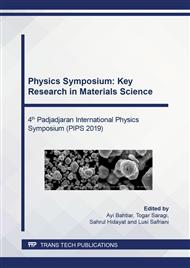[1]
M. Pekguleryuz, K. Kainer, A. Kaya, Fundamentals of Magnesium Alloy, Woodhead Publishing Ltd., Cambridge, UK, (2013).
Google Scholar
[2]
G. Song, Control of biodegradation of biocompatable magnesium alloys, Corros. Sci. 49 (2007) 1696–1701.
DOI: 10.1016/j.corsci.2007.01.001
Google Scholar
[3]
M. Echeverry-Rendon, V. Duque, D. Quintero, S.M. Robledo, M.C. Harmsen, F. Echeverria, Improved corrosion resistance of commercially pure magnesium after its modification by plasma electrolytic oxidation with organic additives, J. Biomater. Appl. 33 (2018) 725–740.
DOI: 10.1177/0885328218809911
Google Scholar
[4]
J.L. Patel, N. Saka, Microplasmic ceramic coating, InterCeram Int. Ceram. Rev. 50 (2001) 398–401.
Google Scholar
[5]
L. White, Y. Koo, S. Neralla, J. Sankar, Y. Yun, Enhanced mechanical properties and increased corrosion resistance of a biodegradable magnesium alloy by plasma electrolytic oxidation (PEO), Mater. Sci. Eng. B Solid-State Mater. Adv. Technol. 208 (2016) 39–46.
DOI: 10.1016/j.mseb.2016.02.005
Google Scholar
[6]
R.O. Hussein, D.O. Northwood, X. Nie, The effect of processing parameters and substrate composition on the corrosion resistance of plasma electrolytic oxidation (PEO) coated magnesium alloys, Surf. Coatings Technol. 237 (2013) 357–368.
DOI: 10.1016/j.surfcoat.2013.09.021
Google Scholar
[7]
C. Blawert, W. Dietzel, E. Ghali, G. Song, Anodizing treatments for magnesium alloys and their effect on corrosion resistance in various environments, Adv. Eng. Mater. 8 (2006) 511–533.
DOI: 10.1002/adem.200500257
Google Scholar
[8]
H. Asoh, S. Matsuoka, H. Sayama, S. Ono, Anodizing under sparking of AZ31B magnesium alloy in Na3PO4 solution, J. Japan Inst. Light Met. 60 (2010) 608–614.
DOI: 10.2464/jilm.60.608
Google Scholar
[9]
L. Li, J. Gao, Y. Wang, P. Bala Srinivasan, J. Liang, C. Blawert, M. Störmer, W. Dietzel, Anawati, H. Asoh, S. Ono, Effect of current density on the microstructure and corrosion behaviour of plasma electrolytic oxidation treated AM50 magnesium alloy, Surf. Coatings Technol. 272 (2015) 182–189.
DOI: 10.1016/j.apsusc.2008.11.008
Google Scholar
[10]
A. Anawati, H. Asoh, S. Ono, Effects of alloying element ca on the corrosion behavior and bioactivity of anodic films formed on AM60 mg alloys, Materials 10 (2017) 11.
DOI: 10.3390/ma10010011
Google Scholar
[11]
A. Anawati, H. Asoh, S. Ono, Enhanced uniformity of apatite coating on a PEO film formed on AZ31 Mg alloy by an alkali pretreatment, Surf. Coatings Technol. 272 (2015) 182–189.
DOI: 10.1016/j.surfcoat.2015.04.007
Google Scholar
[12]
J. Martin, A. Nominé, F. Brochard, J.L. Briançon, C. Noël, T. Belmonte, T. Czerwiec, G. Henrion, Delay in micro-discharges appearance during PEO of Al: Evidence of a mechanism of charge accumulation at the electrolyte/oxide interface, Appl. Surf. Sci. 410 (2017) 29–41.
DOI: 10.1016/j.apsusc.2017.03.088
Google Scholar
[13]
S.A. Adeleke, S. Ramesh, A.R. Bushroa, Y.C. Ching, I. Sopyan, M.A. Maleque, S. Krishnasamy, H. Chandran, H. Misran, U. Sutharsini, The properties of hydroxyapatite ceramic coatings produced by plasma electrolytic oxidation, Ceram. Int. 44 (2018) 1802–1811.
DOI: 10.1016/j.ceramint.2017.10.114
Google Scholar
[14]
T.W. Clyne, S.C. Troughton, A review of recent work on discharge characteristics during plasma electrolytic oxidation of various metals, Int. Mater. Rev. 64 (2019) 127–162.
DOI: 10.1080/09506608.2018.1466492
Google Scholar


